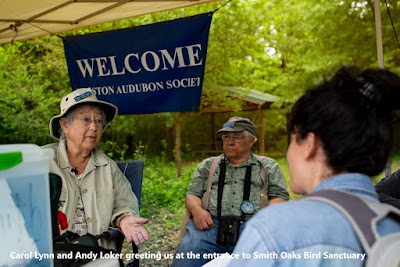I awoke well before dawn on April 6, 2019. A night of fitful, anxious sleep pushed me out of bed. After a year of planning, I was eager to start work at Smith Oaks Bird Sanctuary in High Island, Texas.
Walking about a quarter of a mile east into the sanctuary, I reached the rookery in the middle of Claybottom Pond. I placed my microphones
next to the pond, scrambled up a small hill, nestled myself under a tunnel of
trees, and pressed ‘Record’. Over the next 45 minutes in the pre-dawn light, I
listened to the sounds of hundreds of water birds reverberate across the pond,
through the trees, and into my headphones. It was a moment I’ll never forget.
We chose to begin our journey at High Island because this section of the Gulf Coast is a gateway for migratory birds crossing the Gulf of Mexico into the United States. Here, untold millions of birds make landfall after a 15+ hour non-stop flight across 600+ miles of ocean. Exhausted and near starving, migratory birds make use of any natural habitat that can provide a drink of water, a bite of food, and a moment's rest. Refueling stops like Smith Oaks are critical if these birds are to continue north to their breeding grounds.
But another migration of sort also converges on High Island each spring. Thousands of bird watchers and nature lovers flock from across the country and world to this iconic community on the coast to personally witness the magic of migration for themselves. Our team was there as much for their migratory story as we were for the birds’.We were welcomed to the sanctuary by Carol Lynn and Andy Loker, Smith Oaks’ unofficial gatekeepers. We spent nearly two hours discussing their 35 years of service to Houston Audubon, including their time spent at Smith Oaks. Carol Lynn regaled us with stories of her childhood and encounters with birding royalty like Ted Parker, Roger Tory Peterson, and of course her father, George Lowery. She impressed upon us the destruction of the natural world she’s seen, including the impacts on birds and other wildlife. It was readily apparent that Carol Lynn was also the gatekeeper to our entire journey.
The stories of Smith Oaks and High Island are stories that echo across the flyway. Over a hundred people shared their memories and stories of the outdoors with us. They told us about their relationships with birds and bird watching, as well as hunting, farming, fishing, shrimping, conservation, etc. They spoke of the changes to the land they’ve witnessed and how these changes have at least partially severed their relationships with the outdoors. These same changes have also imperiled the birds sharing the land with us. It’s clear our futures are closely connected.If you’re interested in learning more about the story of Smith Oaks Bird Sanctuary, High Island, and the Mississippi Flyway, we invite you to visit the ‘Voices of a Flyway’ website. We’ve also put together a seven-part podcast of the entire journey, and six interactive web experiences filled with photos, videos, and audio of birds, people, and natural spaces, including those captured at Smith Oaks and on High Island in general.
By Dr. Jacob Job, Research Associate with the Sound and Light Ecology Team at Colorado State University
Jacob works to connect people to the natural world via immersive audio recordings of natural spaces and evocative storytelling. He is the writer and producer of Scientific American's 'National Park Nature Walks'.
---
Links
Voices of a Flyway Interactive Story Map
Voices of a Flyway Soundscapes: High Island Rookery



Comments
Post a Comment